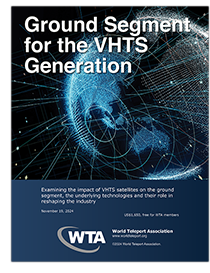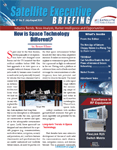New WTA Report Explores How VHTS Satellites are Impacting and Reshaping the Ground Segment
New York, NY, November 19, 2024 – The World Teleport Association (WTA) today released Ground Segment for the VHTS Generation, a new research report that examines the impact of VHTS satellites on the ground segment, the underlying technologies and their role in reshaping the industry. The report is sponsored by Kratos.
“Very high throughput services in GEO, MEO and LEO have gone from concept to reality with unprecedented speed,” said executive director Robert Bell. “Amid all the excitement of developments in space, the crucial need to update ground technology was ignored. Technology providers and teleport operators, however, have seen it coming and are accelerating efforts to create ground segment as flexible and capable as the assets on orbit.”
WTA members can access the report by signing into their accounts on the WTA website. The report is free for WTA Members and available for purchase by others. Members may directly download the report by following this link and logging in with their user name and password.
Quotes from the Report:
A technology expert noted: “A multi-orbit ground infrastructure needs to be global and integrated with the satellites’ traffic orchestration. Real-time traffic orchestration becomes the must-have feature because we will not be able to assign static pools of bandwidth on a certain satellite or group of satellites.”
An expert with a technology provider summed it up: “To support higher data rates, we are now moving into higher frequencies, and we are seeing Ka-band multi-beam antennas for user links and Q/V-band antennas for feeder links, which are crucial components to cope with VHTS mission requirements.”
More on Ground Segment for the VHTS Generation
While all eyes may be on low Earth orbit, the real story is about high-throughput satellites (HTS) and VHTS flying in GEO, MEO and LEO. Since the first HTS satellite, IPSTAR, was launched in 2005, the frequency-sharing, multi-beam architecture it pioneered has become standard in LEO and MEO satcom. Intelsat’s decision to launch its EPIC Ku-band HTS satellites made clear that it would become common in GEO as well. Then came the very high-throughput birds Jupiter 3 with its 500 Gbps and ViaSat 3 with its Terabit of capacity (sharply degraded on the first satellite by an antenna problem). All of this has stacked up challenges for the ground segment. Hub infrastructure must scale to support hundreds of beams, support dynamic allocation of return channels and waveform optimization, handle higher symbol rates and greater throughput. Advanced network management will be needed to handle multi-orbit, multi-beam, multi-satellite handovers.
In this report, teleport and technology executives report on the technical, operational and business challenges they face and the paths they are navigating to achieve profitable growth while meeting new needs.
About World Teleport Association
The World Teleport Association (www.worldteleport.org) has been helping its members aim higher since our founding in 1985. Today, WTA is the leading partner in growth for teleport operators, advocating for their commercial interests and promoting excellence in their business practices, technology and operations. The association publishes best-practice reports and presents webinars on technology changes and their business and market impacts. It also presents events and awards and provides global certification and assessment programs to validate excellence and drive improvement. Aiming higher creates opportunity. Aiming higher brings risk. WTA is dedicated to helping its members seize the opportunities and manage the risks to find the paths to growth in a massively changing market.






